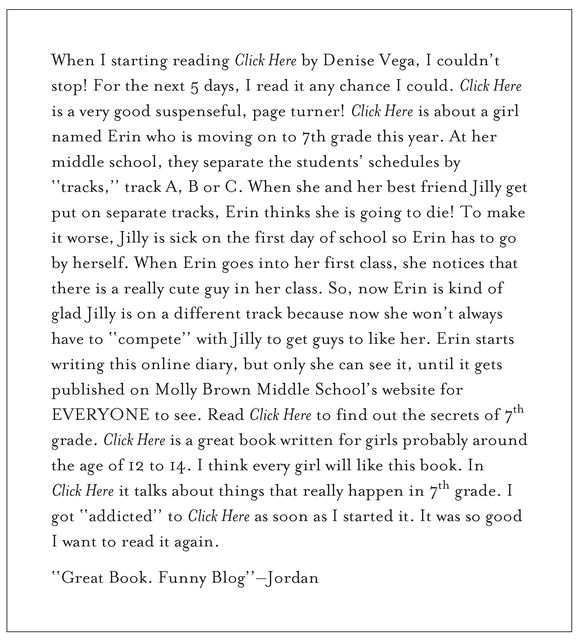The Book Whisperer (17 page)
Read The Book Whisperer Online
Authors: Donalyn Miller,Jeff Anderson

Traditional Practice: Book Reports



In my opinion, the entire goal of a book report is for students to prove to the teacher that they actually read a book by demonstrating their ability to recite, in detail, all of the events or important facts from it. If a student is not a reader, how the book report motivates that student to pick up a book in the first place is never addressed. Some students do not read for many weeks and then power through a book in the days leading up to the due date for the report. They will hammer out a report, breathe a sigh of relief, and revert to a nonreading state until shortly before the next report is due. The report becomes an external motivator in which a grade creates pressure to read. In no way does that kind of motivation mirror the internal drive felt by life readers, for whom the pleasure of reading increases the desire to read. Reading lacks personal significance for students who see the report as the reason for readingâall stick and no carrot. Not only do the requirements for writing book reports fail to encourage students to develop consistent reading behaviors, but the reports are a chore to write and painful for the other students to listen to. After all, who wants to hear a complete summary of a book you may or may not have read? Book reports are also a bore to grade.
The Slippery Slope of Book TalksPerhaps the tedium of book reports is why book talks have replaced book reports in many classrooms. The purpose of a book talk is not to prove to the teacher that you have read a book but to share with other readers a book you have read and persuade them to read it themselves. Recommending a book for the purpose of getting a friend to read it is more in alignment with what adult readers do when they finish a book.
Recognizing the inherent flaws in asking my students to do book reports, I implemented book talks for a time. However, I was still not happy with the results. Students, having already written and presented years of book report summaries, gave away too much information. At the other extreme, when students were asked to share their favorite moment from the book, I often heard, “My favorite part of the book was at the end.”
Book talks did encourage some students to read the books their peers recommended, but I had to set aside at least two days of instructional time so that we could get through all the talks. Again, this was time when my students were not reading and writing. Invariably, several students had the same book to share, and we all had to sit through repeats. I taught my students the term
spoiler
, encouraging them not to give away so much information that no one would want to read the book after they finished talking about it. I then began to question whether the book talks were any better than the reports. I came to the conclusion that they were not. This realization coincided with the discovery that I could not duplicate the classroom design of experts in every respect. I needed to respond to my own observations and instincts about what did and did not work in my classroom.
spoiler
, encouraging them not to give away so much information that no one would want to read the book after they finished talking about it. I then began to question whether the book talks were any better than the reports. I came to the conclusion that they were not. This realization coincided with the discovery that I could not duplicate the classroom design of experts in every respect. I needed to respond to my own observations and instincts about what did and did not work in my classroom.
Providing friends with enough information to interest them in reading a book and getting recommendations from other trusted readers are valid reasons for sharing opinions about books. When we distort this natural conversation among readers into one child standing at the front while all of the others sit up straight, stay quiet, and listen dutifully to hours of presentations, that free-flowing dialogue is lost. This is why I ditched both book reports and formal book talks and moved to book commercials and book reviews.
Alternative: Book CommercialsBook commercials are advertisementsâshort, impromptu testimonials from students about the books that they have read and enjoyed. (Think about how you might tell a friend about a book over lunch.) The intent of a book commercial is to provide students with a forum for sharing the books they love and for recommending those books to other readers in the class.
Once a week or so, often on Fridays at the end of class time, I will ask students whether anyone has a book to recommend to the class. As a means of sharing the books I have read that students might like to borrow, I often present my own book commercials for them. We talk about what I do not reveal about the book in these conversations, as well as what I do say. We also read lots of blurbs and teasers from the backs of books and jacket flaps in order to model our own conversations after these published examples.
Students can stand next to their desk or sit in my green director's chair (a rare treat) and informally share with the class about their book. If anyone else has read the same book, I ask that student to add their opinions of it, too. Students record any books from the commercials that interest them on the “Books to Read” pages of their reader's notebooks, and I do, too.
I keep a class roster on a clipboard and check off the students who share, making sure that everyone provides at least one commercial over the course of the grading period and that no individuals dominate the weekly discussions. I give everyone a grade for their book commercial; we all get to hear about books other readers like; and the entire experience lasts no more than twenty minutes a week. The students are excited to share their books, and we can all talk back and forth about them instead of listening passively to book talks or reports. I do not need to question the comprehension of students who give recommendations because their enthusiasm and strongly held opinions show me that they have read the book and responded to it authentically. If they disliked a book, they can share that, too!
Alternative: Book ReviewsI adore book reviews, as evidenced by the hours I spend each month poring over
Booklist
magazine and studying recommendations from Amazon and Goodreads on the Web. Consider book reviews authentic forums for celebrating books and sharing information about titles in your classroom, too. My students write book reviews and post them on their classroom blog, or they print newspaper column-sized versions and glue them inside the book itself, right alongside the blurbs and reviews of the professionals. While I might choose a book because
Publishers Weekly
has starred it, my students are more likely to pick a book that Riley or Eric recommended!
Booklist
magazine and studying recommendations from Amazon and Goodreads on the Web. Consider book reviews authentic forums for celebrating books and sharing information about titles in your classroom, too. My students write book reviews and post them on their classroom blog, or they print newspaper column-sized versions and glue them inside the book itself, right alongside the blurbs and reviews of the professionals. While I might choose a book because
Publishers Weekly
has starred it, my students are more likely to pick a book that Riley or Eric recommended!

BOOK REVIEW CRITERIA
⢠Quotes from the book
⢠Quotes from famous writers and reviewers
⢠Cliffhanger questions
⢠Personal reactions and opinions
⢠Awards the book and author have won
⢠Recommended reading age
⢠Other books by the same author
⢠Comparisons with other books
For the past week or so, my students have been reading professional book reviews and book jacket blurbs and teasers for the purpose of determining what information professionals include when evaluating books. We've made a chart of the criteria found in these reviews.
Jacob remarks that every book review he read included the word “compelling,” so we add to our chart a list of words that reviewers include to entice the reader and make their book sound interesting:
compelling, action-packed, thrilling, thrill ride, exciting
, and
riveting
.
compelling, action-packed, thrilling, thrill ride, exciting
, and
riveting
.
With a list of criteria from which to begin, students spend the next week composing their own book reviews (see
Figures 6.1
and
6.2
for examples). I am asked to provide quotes for endless reviews because students know that I have read many of their books. I am careful to avoid using
compelling
to describe any book, though!
Figures 6.1
and
6.2
for examples). I am asked to provide quotes for endless reviews because students know that I have read many of their books. I am careful to avoid using
compelling
to describe any book, though!
In order to inspire students to read when school requirements to do so are lifted, we must provide them with authentic opportunities to share with other readers what they love about the books they read. If our classroom practices only serve to assess whether or not students readâor to push our own instructional agendaâthen we are doing little to encourage students to read. Traditional reading instruction that focuses on mandates outside of students and stirs fear-based motivation hijacks reading away from readers. Give it back to them.
Traditional Practice: Reading LogsMany permutations of the reading log are used in classrooms, but all have common features. Students are asked to record how many minutes or pages they read over a given time period. Teachers require their students to read a certain number of minutes or pages per day, week, or grading period. Keeping these logsâwhose purpose is for students to document their independent reading as proof to their teachers that they are readingâis an ineffective practice because recorded time spent reading is no proof that students actually read much. Students may write down how much or how long they read nightly but not finish many books. A conversation with my students during my first year of teaching revealed the futility of the home reading log. Simply put, the logs do not accomplish what they are supposed to accomplish. This lesson was one of the first my students taught me. It went something like this:
Source: Riley, grade 6.

Source: Kenan, grade 6.

“OK, guys, it's Fridayâtime to turn in your reading logs.” Groans and the rifling of twenty-five papers ensue.
“Hey, Mrs. Miller, my dad forgot to sign my reading log.”
“Well, I guess you will have to get him to sign it over the weekend and bring it back in on Monday.
I continue, “Doesn't your dad sign it every night? You are supposed to get it signed every night after you read.”
“My dad says he doesn't have time to do that. I just have him sign it on Friday mornings when we are in the car.” A classroom full of heads nodding in agreement tells me that this is a common practice.
“Are you telling me that your parents don't know whether you are reading every night or not? They are not keeping track of how much reading you are doing at home?”
“My mom believes me when I tell her I am reading. She just signs the log because you make us do it for a grade.”
A chorus of “Yeah, me, too” circles the room.
Julie pipes up: “Mrs. Miller, I hate that log. I always forget to write down what I read each night, so I just sit down and fill it out the day we have to turn it in. I am not going to keep that log in bed with me at night so that I can write down what I read.”
“Just because we fill out the log doesn't mean we actually did the reading,” Amanda says.
When I questioned the rest of my students, it became clear that most of them were not keeping track of their daily reading in the log, and that most of their parents were not monitoring how much reading, if any, their children were doing at home. Lacking parent buy-in and perceived as a burden by students, the reading log begs to be fabricated. Deceitful, I suppose, but I imagine there are students in classrooms everywhere who fake their reading log at some point, even among those who read diligently. As a parent, I'll admit to signing papers hastily shoved into my hand by my daughters when we are in a mad rush to get out the door in the mornings.
Other books
Swim Until You Can't See Land by Catriona Child
Lucky Dog Days by Judy Delton
Control Me by Shanora Williams
A Murder in Auschwitz by J.C. Stephenson
Between Friends by Lou Harper
Forever Changes by Brendan Halpin
Summer at Little Beach Street Bakery by Jenny Colgan
The Book of Kills by Ralph McInerny
VC03 - Mortal Grace by Edward Stewart